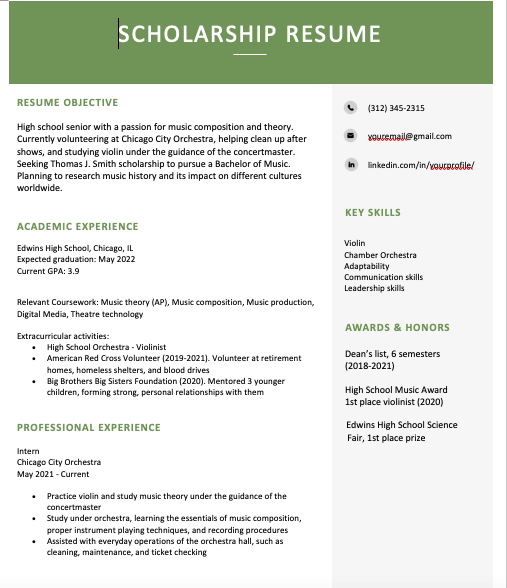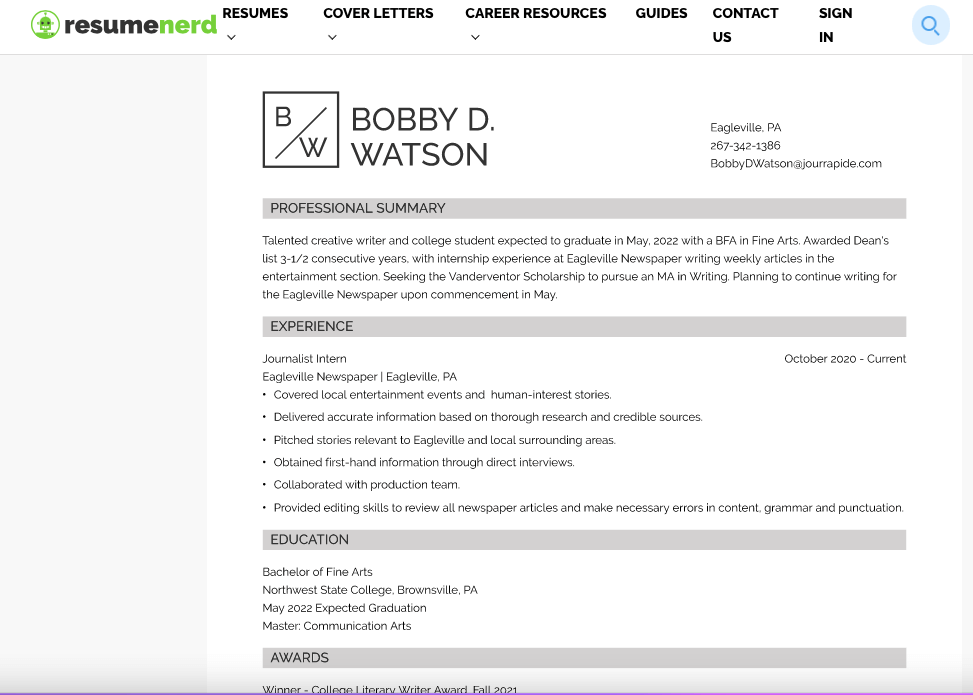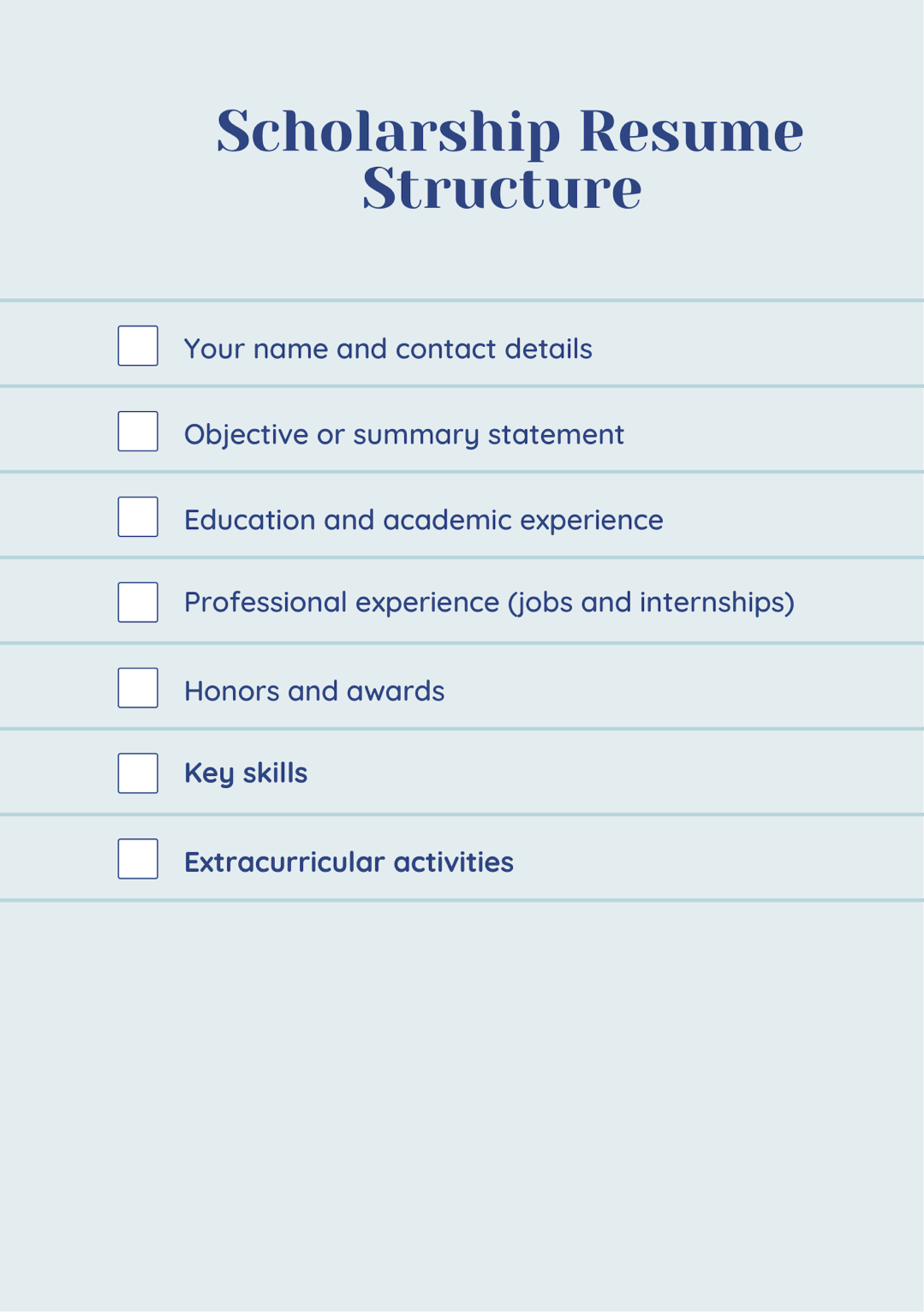Scholarship Resume Examples & Writing Guide
How to write a scholarship resume?

A strong scholarship resume doesn’t come from trying to look perfect. It comes from showing the real work, dedication, and experiences that shaped you. Scholarship committees want to understand not just what you’ve done, but what motivates you and where you’re headed. That’s why the way you organize and present your accomplishments matters. In this article, we look at how to build a resume that highlights your strengths clearly and gives reviewers a genuine sense of who you are as a student and a future professional.
When applying for private, merit-based, or need-based scholarships, you may be asked to submit a resume along with other materials. A good resume can present your academic achievements and extracurricular activities in a good light, thus helping you get scholarship funding.
Getting started with a resume can be tough, but we have you covered. In this post, you will find expert tips and guidance for composing winning scholarship resumes. Keep reading to find out:
- Resume writing tips to help you impress scholarship committee members
- College resume template and samples
- How to list scholarships on a resume for job application.
Need a strong scholarship resume but have no time to write it yourself? Try our resume writing service. We will connect you with an experienced writer who will tailor your resume to the targeted scholarship. The writer will highlight the exact qualifications the program asks for to help you get financial aid for your further education. Order your resume today with a special student discount!
Why do you need a scholarship resume?
You might be asking yourself "Why do the admissions committee members ask to include a resume in your scholarship application?" The answer is simple. The scholarship committee needs your resume to evaluate your academic performance, extracurricular activities and engagements as a college student.
A good resume presents this information in a structured, logical way. It also emphasizes your academic experience and achievements, as well as your fit with the program's values. A powerful resume can increase your chances of being selected for a scholarship!
A scholarship document differs from a regular one that you use for a job application. It emphasizes academic success, achievements, and community service, and the highlights of your academic career over hands-on skills and work experience.
Below, we'll see some examples of the best examples and explain how to write it.
Scholarship resume examples
To get inspired to write your resume, see the effective examples below.
High school student example

Why is this a good resume?
- This resume template is one page long (as recommended for this type of resume) and has a neat visual structure and white space between the sections. So, it instantly makes a good impression.
- The objective at the top, summarizing the candidate's experience as a violinist, volunteer experience, passion for music, and research interests. Thus, the candidate positions themselves as a good fit for a musical scholarship.
- It features academic awards and honors, thus making the impression that the candidate is ambitious and driven. It also expands on academic and professional experience, both of which are connected with music.
- The candidate uses color in this template. It makes the document instantly pop and highlights the key sections.
College student scholarship resume example
Image: https://www.resumenerd.com/blog/scholarship-resume-example

Why is it a good resume?
- This resume sample starts with a Professional Summary section. This section features academic achievements (Dean's List), extracurricular activities in journalism, and the candidate's plans for further professional development. Such a summary will surely impress the scholarship committee members.
- The resume lists internship experience in journalism with a detailed list of responsibilities. The candidate also included an extensive list of awards and honors that prove their outstanding skills. Plus, the resume has extracurricular activities showing that this candidate has a well-versed personality, which can set him apart from other scholarship applications.
- The document has a logical structure, the correct order of sections, and fits into one page. Thus, the committee members can efficiently locate any information they need.
The above resume samples showcase academic achievements, a passion for the chosen fields, and relevant experience. Plus, they are concise and focus on the most relevant information. Below, you will find actionable tips for writing a resume like these.
Tips to write an effective resume
To win scholarship funds for your college education, prepare a well-organized resume that will showcase your best strengths. Based on the above resume templates, here's how you can approach writing your own resume.
Use the right resume structure
As we've mentioned above, the content of the resume for a college scholarship is different from that of a resume for a job. To write the resume, you need to focus on academic activities, projects, and your fit with the organization's values.
Here are the sections that you should include:

- Name and contact details. All resumes start with your contact details. Add your phone number, a professional email address, and your location. Double-check to make sure the information is accurate.
- Jbjective or summary. This section is 3-5 sentences long. In it, you pitch your biggest achievements and experience highlights to the committee, inspiring them to pay closer attention to your resume.
- Academic experience.This section lists your school name and degree, academic awards and honors, relevant coursework, and any other activities you were involved in while in high school/college.
- Professional experience. If you have had relevant internship experience, volunteering projects, or employment, add them to this section. Your college scholarship application will benefit from it.
- Honors and awards.If you have plenty of awards to brag with, consider adding a separate section for them. Add the name of the award, the awarding body, and the year you received it.
- Key skills.This section isn't a must. But it often helps to add 5-10 skills you consider the most important for your future education and career.
- Extracurriculars. Use this section to show off your personality. Highlight your experience in community service, and activities in the arts or athletics.
Note that the final resume structure and content depend on the guidelines for the scholarship application. Study them carefully before writing the document and follow the suggested structure. Otherwise, your application might be rejected.
Add a compelling objective
You can find the objective in most resume templates. This section helps you quickly introduce yourself, show your key selling points, and explain why you are a good candidate for a scholarship.
Here's how to write the effective objective/summary section:
- Make it convincing. Focus on the most important highlights from your college study or academic career. Add only relevant relevant education, achievements, areas of expertise, or activities.
- Keep it to 3-5 sentences. The purpose of this section is to summarize the key facts about you for the committee. To write a great resume, keep it short and don't overload the readers with unnecessary details.
- Show what you plan to do next. In the last sentence, share what you plan to do after receiving the scholarship, i.e. in what areas you will continue your research and how you would like to contribute to your field.
Example:
Driven individual seeking a scholarship to pursue an MA degree in Business Management. Maintained a GPA of 3.9. Committed to leveraging the scholarship opportunity to expand my understanding of global business trends, and leverage skills in business analysis, financial management, and developing innovative solutions to new challenges, and build a successful career as a leader in the technology industry.
Showcase your academic experience
The Academic Experience or Education section summarizes your educational background and achievements. It should show that you qualify for the scholarship and prove that you are an ideal candidate for the scholarship. Here's what to highlight in this section:
Your degree. If you are a high school graduate, add information about it. Yet, if you are writing a college or postgraduate student resume, remove the information about your high school and only list your degree.
Here's what exactly you should include:
- the name of your academic institution
- your major and degree
- graduation date (if you are still a student, add expected graduation date)
- your GPA, if high
- achievements, academic interests, and extracurriculars.
Your academic achievements. To win college scholarships, you need to show superior academic results. The best way to do this is through accomplishments. Here are the examples of achievements that can enhance your resume:
- High GPA
- Dean's list
- Graduating summa cum laude
- Winning a student award, etc.
Coursework and thesis (if relevant). You may add relevant coursework or the topic of your thesis to a resume if it helps make your resume more convincing.
Not sure what exactly to include on your resume?Consider an experienced or certified professional resume writer. An experienced writer will craft a punchy objective, organize the document properly, and tailor it for your targeted scholarship program. Try our services today with your special 20% welcome discount!
List relevant work history
Professional history is a significant section of your resume. Try to make it detailed enough so that the committee members can evaluate your strengths, work ethic, and potential. If you were an intern or a trainee, describe your experience in detail anyway, focusing on the specific results you've accomplished.
Add the job title, company name, and dates of employment. Use a common job title that communicates exactly what you did. Do not write just Trainee or Intern. A Digital Marketing Intern is a much better option. List your jobs in reverse chronological order. Thus, your most recent employment will appear at the top of the list.
Write in bullets. List your responsibilities and achievements using bullets, not paragraphs. Paragraphs on a resume are out of date, moreover, they are more difficult to read.
If you don't have paid experience, worry not. For scholarship application, it is more important to showcase a strong academic background, your plans for the future, and how you share the values of the scholarship organization. You can impress the scholarship selection committee even without paid jobs on your resume.
Use figures and percentages: they show that you hold accountability for your contribution to the organization you work for. Be concise when describing your daily duties. You needn't write a laundry list of responsibilities you had. Focus on the key highlights and write in short sentences. Ideally, you should include 4-6 bullets per role.
Add extracurricular activities
List activities, projects, and organizations you were involved in in your college years. Such activities will show that you're a well-rounded personality who has many interests outside of the classroom. Here are some examples of activities to mention on your resume:
- Membership in the student council and contributing to student organizations in college, especially if you had leadership positions
- Participating in college sports
- Involvement in debate club, photography club, or any other interest-based club
- Contributing to research projects and assisting professors with experiments
- Participating in music ensembles, college theater, or organizing art exhibitions.
Highlight relevant skills
The Skills section is not a must-have for a winning resume. Yet, if you can boast plenty of valuable skills in your field of study, mention them on your resume. The template above features skills, too.
Here is how to highlight skills on a student resume:
- Avoid obvious skills. Everyone can tell they have organizational skills, communication skills, and time management abilities. Yet, you should include such skills if they are crucial for your target career and you can share specific examples of how these skills helped you ace college studies and personal projects. In all other situations, focus on more specific, technical skills.
- Include 5-10 skills. Keep your skills list concise. Focus on the most relevant skills that can set you apart from the competition.
- Don't lie! This applies not only to skills, but to other resume sections as well. Don't stretch the truth to impress the scholarship selection committees and get scholarship funds. With a background check, it is easy to reveal the truth. Your reputation will be damaged, which can reflect on your ability to get scholarships and on your academic career.
Format the document professionally
After finishing work on your resume content, it's time to format and organize it visually. Do not neglect the formatting whatsoever. A neat, visually appealing formatting can contribute to the first impression about you.
Here's how to format resumes best:
- Use the chronological format. List your jobs, projects, and degrees starting with the most recent one.
- Make section headings visible. Use a bigger font for subheadings and add white space between headings to make your resume easy to read.
- Boldface your job titles, institution names, and other important info. Thus, the committee reviewing your resume will instantly spot the most important details.
- Check for consistency. Use the same font type and size in the document. Check that indents, margins, formatting style, and punctuation are the same throughout your resume.
With these actionable tips, you will manage to write a resume that highlights your academic achievements and your fit for the program.
How to list scholarships on a resume?
Scholarships awarded by your school or other institutions can showcase your excellent academic performance and add value to your resume. There are two ways to list scholarships on your resume:
- In your Education section
If you got a scholarship from your college or university, list it in the Education section next to the institution's name and your degree.
- In the Honors/Awards section
If you received a scholarship from a reputable organization or government, it makes sense to list it separately with other achievements. The same works if you received multiple scholarships from different organizations.
Example of listing the scholarship on your resume
Awards
John Gordon Mulford Scholarship 2022
University of Sydney Business School
Author: Editorial Team at ResumePerk.com
Reviewed by: Certified Career Expert
Last updated: December 2025
Recommended reading:


